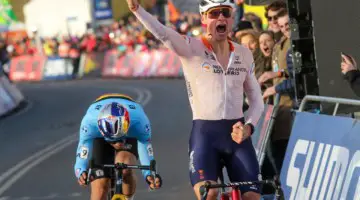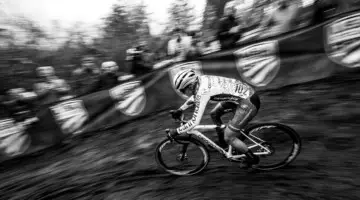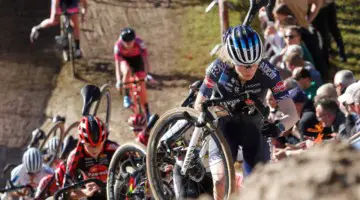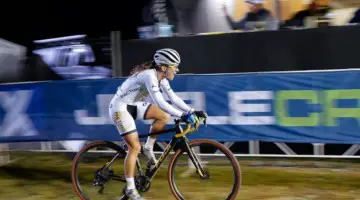More great strides in the name of women’s cyclocross were made at the UCI Cyclocross Commission meeting last Monday. This was recently confirmed by two Commission members, Sven Nys who spoke of the issue on Belgian TV and Helen Wyman, who is an idol to many when it comes to women’s struggle for equality within the racing world.
When Wyman, superhero to the women’s ‘cross peloton, hit the business end of the ‘cross scene three seasons ago, she had clear objectives.
“My goals were to equalize the prize money for elite men and women, develop a U23 women’s category and filter through all those rules to make essential changes for the good of the sport. I also wanted to ensure that all professional ‘cross racers have clear, set pathways to ensure they can carry out their sport at the World Cup level.”
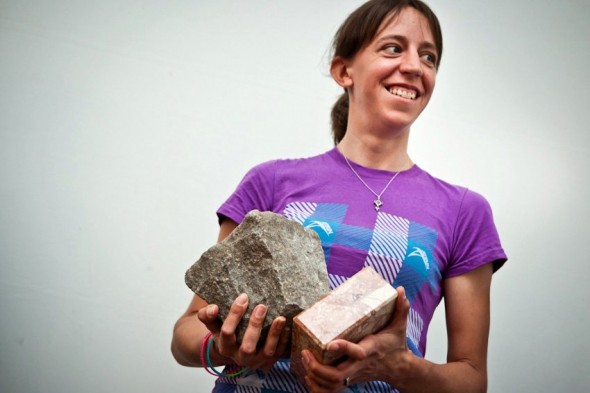
File photo of UCI Cyclocross Commission member Helen Wyman, who is hard at work bringing equality to cyclocross.
How Changes Are Made at the UCI
According to Wyman, “[t]he way the system works for the commission is that we meet during the year and discuss many things. At the February meeting, we decide on any changes we want to make. Sometimes there are a lot of discussions, sometimes it’s very simple. Then the agreed changes are submitted to the UCI Management Committee who meet in June. The management committee then agree upon or reject the proposals. Once agreed, the rules and publications are then updated on the UCI website and made public around the beginning of July.
So as you can see, the process for change is actually quite a long one although the discussion and agreements are made for us on just one day. Sometimes it can be a little frustrating because when something exciting for women’s ‘cross is agreed upon, I want to shout about it!”
What’s Been Accomplished So Far
In her time in office, Wyman has increased prize money for women in every way possible. She equalized Category 2 race prize money for the Elites, doubled the Category 1 payout, slightly increased the payouts for individual World Cup rounds and significantly increased the overall World Cup ranking prize purse.
Wyman has also seen other changes take shape. Women now race for a minimum of 40 minutes, with a maximum of 50 minutes. [Men’s racing time remains at 60 minutes except for World Cups, which can run upwards of 70 minutes, ed.] Additionally, there is now a U23 Women’s classification for National Championships with UCI points, a European Championship event and a World Championship event. They too race for 40 minutes, up to a maximum of 50 minutes.
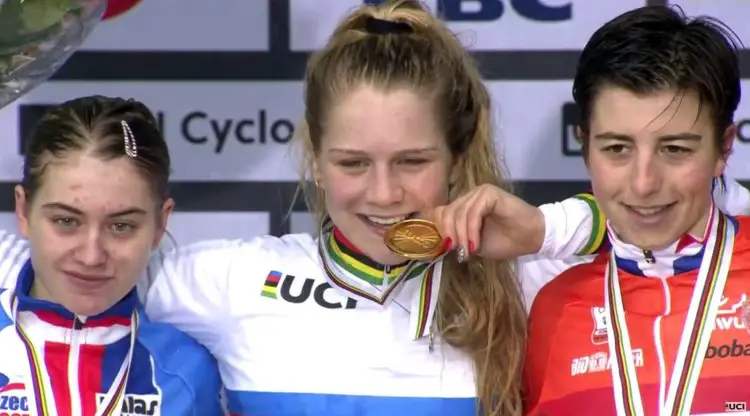
Wyman and the UCI Cyclocross Commission are looking at ways to bring more U23 Women’s races to existing events.
A major change that Wyman introduced for both men and women was to allow all riders in the top 50 UCI classification to be able to automatically enter World Cup events.
“For me it was important that the best ‘cross racers are able to race World Cups as they are as important for a rider’s sponsors, career, progression and television time as any other race. This means some countries get more riders than previously allowed, but they are the best riders.”
Wyamn also pointed out that “[t]his also provides a target for riders if they are from a country like Belgium or USA, to help to globalize the sport. Belgian UCI points in Category 1 and Category 2 races are basically a lockout, so good riders have to get their points elsewhere. This season you may have seen how great the EKZ ‘cross series was in Switzerland. These races are helped by the need for good riders to find ways into the top 50.”
The Challenge with World Cup Prize Money
While Wyman was able to work her magic with most events regarding the significant increase in women’s prize money, the individual UCI-funded events are a different story.
“The overall World Cup now is a huge prize pot, although still not equal. But as for individual rounds, the disparity remains huge. I have proposed a multitude of equalization methods with the fairest being to add up the current prize pot [for Elite Men and Women, ed.] and divide by two. Unfortunately this has been rejected every time. The big problem we have are the sums of money. It’s not difficult to equalize a prize fund that is small. But for a World Cup race, you’re talking about 39,500€ for the men and just 10,400€ for the women. Without increased sponsorship or specific sponsorship for the women’s events, I am currently hitting a brick wall on this one,” explains Wyman.
“However I will definitely keep working on this as it’s really important that when I do end my term on the commission that I have achieved everything I set out to. I am an athlete and you do not achieve in this sport without hard work and dedication. And I apply that to everything I have a passion for. So to me it’s not over till it’s done!”
More Changes Are Coming
Wyman though did confirm the major rumor that despite the challenges they are working to equalize Elite Women’s and Elite Men’s prize money for all Category 1 races starting with the 2016-17 season. It still has yet to be approved by the UCI Management Committee in June though, but hopefully it will be passed without a problem.
“Yes, changes are being made for Category 1 women’s prize money next year which is fantastic news and can make a huge difference again for women’s ‘cross,” exclaims Wyman. “When a rider like Sanne Cant can earn 10,735€ more in Category 1 prize money with the same results she had last season, this is progress.” The changes, when finalized, will be available at the beginning of July in the financial obligations section on the UCI website.
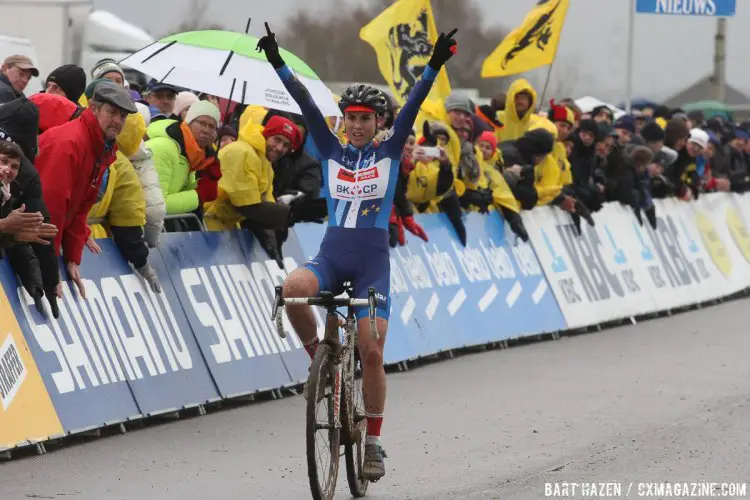
File photo of Sanne Cant at the 2015 Koksijde World Cup. Equal or even increased payouts for Elite Women in World Cup and c1 events would see a rider like Cant earn more income. © B. Hazen / Cyclocross Magazine
There are also talks regarding the U23 Women’s category and selection and classification for World Cups. They have discussed how and when to bring in a separate U23 Women’s event, although currently the earliest Wyman sees it happening is for the 2018-19 season. Of the many suggestions Wyman offered the one that was quite positively received was to start with a U23 Women’s event in the World Cup the week before the World Championships so racers can get a feel for the competition.
“Europeans haven’t really grasped the concept of how many races can be run on one day; they think that having five races is not achievable. To me it’s pretty comical. Having raced in the USA for six years now, I think five is nothing. But I do understand that this is a very new category and we do need to develop it over time. For women in Europe, development is all about the impression we leave. In my opinion, the first impressions count the most, like with the television coverage this season. Having said that, I am pushing for it to be implemented right away.”
Another proposal from Wyman was to increase the duration of the Elite Women’s races.
“This season we still had short races and this was discussed in length at the meeting. I would like to see them increased to 50 minutes [from 40 minutes, ed.], then eventually to one hour. However, this is trickier due to the 16 year olds allowed in Elite Women’s races. Until the U23 category is established, one hour would be wrong. I am still pushing for 50 minutes in the near future. I think it gives us more tactical racing, changing how attacks are made [and] making more group racing for a longer period of time.”
TV Coverage Woes
Last season, exclusive television broadcasting rights for many races were purchased by Telenet, a cable television provider. Some of their purchased races were shown on their “members only” channel, while others were shown on their pay-channel. This made for many unhappy Belgians. For the first time, ‘cross races were no longer easily accessible. For non-Telenet members, this meant paying exorbitant fees to switch over to Telenet as well as pay an extra monthly premium to view their pay-channel.
Wyman says, “The television coverage of women’s ‘cross outside of UCI sponsored events is not something that we can control; we can merely influence opinions. Every World Cup cyclocross is now shown on Play Sports [Telenet’s pay channel, ed.] and the UCI YouTube channel.”
While there may not be anything the UCI can do to reverse the possible damage done by the partial privatization of ‘cross on television, Wyman does share some positive numbers on viewers of women’s ‘cross races shown on free-access channel Sporza.
“There was an average of 530,000 viewers across all 24 races shown live on Spoza, which is only around 8-10% less on average than the men’s television figures. The women’s race in GP Sven Nys Baal maxed out at 734,000 viewers; that’s 63% of the market share!”
Looking into the future, Wyman says, “Women’s ‘cross is just as interesting as the men’s in different ways. Having a full season of television viewing figures gives Golazo [organizer of most cyclocross races, ed.] the opportunity to sell this to their sponsors. They can bring more money into the sport specifically focusing on these huge television viewing figures. They basically now have an extra hour of television exposure as a direct return to sponsors. By promoting women’s ‘cross they bring more money for everyone. Who wouldn’t be happy for this?”
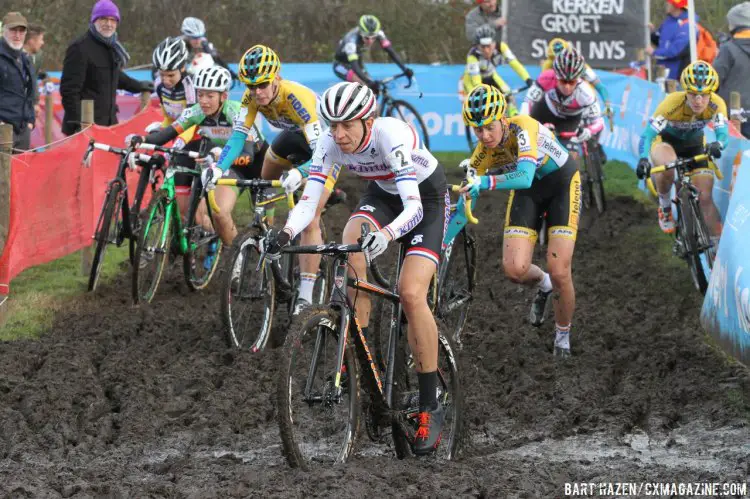
File photo of Wyman at BPost in Essen. Wyman knows first hand that the racing action in the Elite Women’s field is top notch, which makes for good viewing and in turn good advertising opportunities. © Bart Hazen/Cyclocross Magazine
As for Telenet, they paid a large sum of money to be title sponsor of the 2016-17 World Cup Series, and are basically funding cyclocross at that level. Considering Telenet wants the best direct return on their investment, Wyman proposes they set up a pay-per-view internet platform for users outside Belgium so that folks can access all the races for a nominal fee–whether it be charged per race, per month or per year. “However I don’t know who to tell this to,” quips Wyman with a grin.
As for the Belgians’ dilemma, Wyman adds, “Television packages are crazy expensive already. I get that. But you can buy a subscription as a Belgacom [a Telenet competitor, ed.] user. It costs 36€ [per month, ed.] instead of the 17€ extra I pay as an existing Telenet user.”
As for UCI’s YouTube channel geo-restriction in certain countries like Belgium and USA, the UCI is looking into unblocking it for American viewers who want to watch World Cups. For Belgian viewers, this seems to be a lost cause for the moment due to Telenet’s broadcasting rights.
In addition to the fine work done by the UCI Cyclocross Commission, women ‘crossers have yet another reason to celebrate. The new women’s BPost Bank Trofee series called Ijsboerke Trofee has just raised its overall prize purse to 30,000€, while television sender VRT who broadcasts the series just renewed their contract to include the women’s races for two more seasons.
Wyman for President?
Wyman joined the UCI Cyclocross Commission in September 2013 and has served for three ‘cross seasons thus far.
“I won’t stop pushing. I have two more seasons on the Commission, and intend to do all I can to help the future riders in my four years. Then I’ll hand it over.”
Usually a member serves a four-year, five-season term. But if they ask Wyman to stay on, she says she is surely up for the challenge. Considering how much she’s already done in three seasons, we look forward to how far she can take us in three more!























